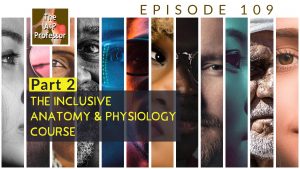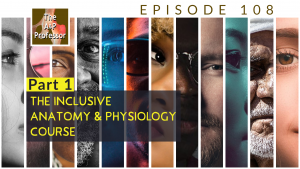This episode continues a discussion of the many simple strategies available for making our anatomy and physiology course more inclusive. Here, we learn eight more easy ways to make our courses work better for all learners.
0:00:00 | Introduction
0:00:46 | More on the Inclusive Course
0:07:51 | Sponsored by AAA
0:08:38 | 8. Student Interest Survey
0:14:35 | 9. Inclusive Office Hours
0:24:22 | Sponsored by HAPI
0:25:27 | 10. Valuing Diverse Viewpoints
0:29:08 | 11. Inclusive Classroom Demeanor
0:55:44 | Sponsored by HAPS
0:56:38 | 12. Learning from Mistakes
0:58:56 | 13. Suggest a Different Instructor
1:08:33 | 14. Many Challenges Are Invisible
1:13:12 | 15. Practice Love
1:16:01 | Staying Connected
★ If you cannot see or activate the audio player, go to: theAPprofessor.org/podcast-episode-109.html
🏅 Apply for your credential (badge/certificate) for listening to this episode: theAPprofessor.org/podcast-episode-109.html/#badge
❓ Please take the anonymous survey: theAPprofessor.org/survey
☝️ Questions & Feedback: 1-833-LION-DEN (1-833-546-6336)
✔️ Follow The A&P Professor on Twitter, Facebook, Blogger, Revue, Tumblr, or Instagram! @theAPprofessor
📰 Get the almost-daily TAPP Science & Education Updates theAPprofessor.org/updates
Good teaching cannot be reduced to technique; good teaching comes from the identity and integrity of the teacher. (Parker Palmer)
More on the Inclusive Course
7 minutes
This episode—and the previous one—discuss a large basket of practical ways we can make our anatomy and physiology course more inclusive. Here, we review the previous 7 tips and then set the stage for 8 more tips. And some news and updates.
★ Association of College & University Eductators (ACUE) toolkit (various resources for the inclusive course) AandP.info/inclusive-teaching-6be1c1
★ ADVANCING DIVERSITY AND INCLUSION IN HIGHER EDUCATION (report on benefits of making courses inclusive) AandP.info/8879cb
★ Burnout! A Chat with Rebecca Pope-Ruark | TAPP 91
★ Unraveling Faculty Burnout: Pathways to Reckoning and Renewal Paperback by Rebecca Pope-Ruark (Author) geni.us/EBSTK
★ Dr. Amanda J. Meyer on Twitter @amandameyerphd
★ ★ Use services like https://cloud.name-coach.com or https://namedrop.io to get students to pronounce their preferred names (and pronouns if they want) so you can learn the correct way to address them
★ HAPS Town Hall Archives AandP.info/HAPStownhall
Sponsored by AAA
1 minute
A searchable transcript for this episode, as well as the captioned audiogram of this episode, are sponsored by the American Association for Anatomy (AAA) at anatomy.org.
Don't forget—HAPS members get a deep discount on AAA membership!
8. Student Interest Survey
6 minutes
The more we know about students, the more we can figure out ways to include them in our course.
★ Answer Garden (the Answer Garden for Kevin's Pre-A&P course) https://answergarden.ch/164268
★ ACUE toolkit #8 (resources related to this tip)AandP.info/inclusive-teaching-2986ca
9. Inclusive Office Hours
9.5 minutes
Are our office hours set up for our own convenience? Or do they instead reflect the diverse needs of our students? Learn how Kevin customizes his office hours by using an online scheduler.
★ ACUE toolkit #9 (resources related to this tip) AandP.info/inclusive-teaching-e4fcde
★ Kevin's online scheduler (combined view at AcuityScheduling; only the "student' appointment is linked in the course syllabus) AandP.info/kevin-schedule
★ Link to other scheduling apps: AandP.info/best-scheduling-79b8df
Sponsored by HAPI Online Graduate Program
1 minute
The Master of Science in Human Anatomy & Physiology Instruction—the MS-HAPI—is a graduate program for A&P teachers, especially for those who already have a graduate/professional degree. A combination of science courses (enough to qualify you to teach at the college level) and courses in contemporary instructional practice, this program helps you be your best in both on-campus and remote teaching. Kevin Patton is a faculty member in this program at Northeast College of Health Sciences. Check it out!
10. Valuing Diverse Viewpoints
3.5 minutes
If we set expectations for valuing diverse viewpoints in our course—especially with the help (and buy-in) of our students—we can ramp up the inclusiveness of our course.
★ ACUE toolkit #10 (resources related to this tip) AandP.info/inclusive-teaching-086228
11. Inclusive Classroom Demeanor
26.5 minutes
A playful class atmosphere is—by its very nature—an inclusive classroom atmosphere. The more flexible and playful our course is, the more inclusive it can become.
★ Playful & Serious Is the Perfect Combo for A&P | Episode 13
★ Why Deadlines Are Important (blog post for A&P students; recommends meeting deadlines but suggests asking for flexibility when needed; link to this post from your course) theAPstudent.blogspot.com/2013/10/why-deadlines-are-important.html
★ Faculty Mindsets & Minority Student Achievement Gaps | Journal Club | TAPP 71
Sponsored by HAPS
1 minute
The Human Anatomy & Physiology Society (HAPS) is a sponsor of this podcast. You can help appreciate their support by clicking the link below and checking out the many resources and benefits found there. Watch for virtual town hall meetings and upcoming regional meetings!
12. Learning from Mistakes
2.5 minutes
We cannot evolve to be more inclusive faculty if we do not recognize and correct our mistakes.
★ Making Mistakes Teaching Anatomy & Physiology | Episode 63
13. Suggest a Different Instructor
9.3 minutes
Sometimes, things simply do not click between you and a student—possibly thwarting their success. If possible, a student may benefit from switching to a section with a different instructor.
★ The relationship between psychological identification with instructors and student ratings of college courses (research article from Instructional Science) AandP.info/psychological-identification-ad33fa
14. Many Challenges Are Invisible
4.5 minutes
If we are on the lookout only for visible diversity and visible challenges our students may face, we are going to miss the many different invisible challenges. If we want our course to be more inclusive, we must consider the invisible.
★ Invisible Disabilities and Postsecondary Education (article from DO-IT) AandP.info/invisible-disabilities-cc24a5
★ Disability and Higher Education: “But You Don’t Look Disabled": Legitimizing Invisible Disabilities (article from the UN) AandP.info/disability-higher-d12803
15. Practice Love
5 minutes
Practicing love—compassion, empathy, and kindness—for all our students is the foundational strategy that underlies all the tips the given in these two episodes on making our course more inclusive.
★ The Value of Empathy in Academia: Why You Should Care (article from American Society for Microbiology) AandP.info/value-empathy-795792
If the hyperlinks here are not active, go to TAPPradio.org to find the episode page.
★ More details at the episode page: theAPprofessor.org/podcast-episode-109.html
★ Transcript available in the transcript box: theAPprofessor.org/podcast-episode-109.html
★ Need help accessing resources locked behind a paywall? Check out this advice from Episode 32 to get what you need! my-ap.us/paywall
Take The A&P Professor experience to the next level!
★ theAPprofessor.org/community
Earn cash by referring other A&P faculty to this podcast:
Tools & Resources
★ TAPP Science & Education Updates: theAPprofessor.org/updates
★ Amazon: amzn.to/2r6Qa3J
★ Text Expander: theapprofessor.org/textexpander
★ Rev.com: try.rev.com/Cw2nZ
★ Snagit & Camtasia: techsmith.pxf.io/9MkPW
★ Krisp Free Noise-Cancelling App: theAPprofessor.org/krisp
★ JotForm (build forms for free): theAPprofessor.org/jotform
★ The A&P Professor Logo Items: https://www.teepublic.com/stores/the-a-p-professor
Sponsors
★ Transcript and captions for this episode are supported by the American Association for Anatomy | anatomy.org
★ The Human Anatomy & Physiology Society provides marketing support for this podcast | theAPprofessor.org/haps
★ Distribution of this episode is supported by the Northeast College of Health Sciences online graduate program in Human Anatomy & Physiology Instruction (HAPI) | northeast.edu/hapi
Clicking on sponsor links helps let them know you appreciate their support of this podcast!
Follow The A&P Professor on Twitter, Facebook, Blogger, Revue, Tumblr, or Instagram @theAPprofessor
The A&P Professor® and Lion Den® are registered trademarks of Lion Den Inc. (Kevin Patton)
As an Amazon Associate I earn from qualifying purchases. I may be compensated for links to sponsors and certain other links.
Click here to listen to this episode—or access the detailed notes and transcript.





